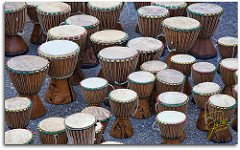by Manuel Marino | Drums, Music

Photo by Frank Kehren
Nothing represents African music more than percussion instruments. They are a ubiquitous presence in every special occasion within an African community. In ancient times, African music served as a way to bring people together, with social gatherings, meetings, and ritual events often accompanied by the rhythmic sounds of percussion instruments. Here are some African percussion instruments that you are likely to encounter in any part of the community.
The Djembe Drum
The djembe drum is easily recognizable by its animal skin-covered head. It has a wider top half and a slimmer lower half, resembling a goblet. Traditionally, the body is made from a hollowed-out log to enhance its acoustic properties. The drumhead is tightened using ropes, although modern variations may use steel hoops, nylon core ropes, and rubbers for tuning. The djembe serves as the centerpiece of the percussion section, producing different tones and rhythms depending on its size and style. It is played by striking the drumhead with fingers or hands to create a range of tones.
Udu
The “udu” is a clay vessel that was originally used for drinking. This percussion instrument produces sound through an additional hole located on its body. The sound … ...Read the rest.
“Percussion Instruments”
by Manuel Marino | Music
Percussion instruments have a rich history and are widely used in music. Often found in folk music, these instruments add diversity and a unique charm to musical compositions. For example, in India, two pieces of flat metal are struck to create a bell-like sound, which is commonly used in temples and prayer places across the country. Other common percussion instruments include drums, pianos, and xylophones.
All percussion instruments can be broadly divided into two main categories: membranophones, which produce sound when struck, such as drums, and idiophones, which produce sound on their own, like triangles. The division can also be made based on tuning, along with other subgroups. Some instruments can be tuned, while others cannot.
Percussionists are often asked to play non-percussive instruments as well. These instruments can include police sirens, glass harmonicas, lion’s roars, and wind machines. As percussionists play such a wide range of instruments, creating various melodies, they are usually among the most skilled musicians in the industry.
Percussion instruments are the heart of musical performances. It is difficult to name three or four songs from the traditional or pop charts that do not utilize percussion instruments. Since the time of early composers like Mozart, all … ...Read the rest.
“You Cannot Have Good Music Without Percussion”


 Manuel is a passionate, driven, and techsavvy AV technician,
Manuel is a passionate, driven, and techsavvy AV technician, 

Recent Comments